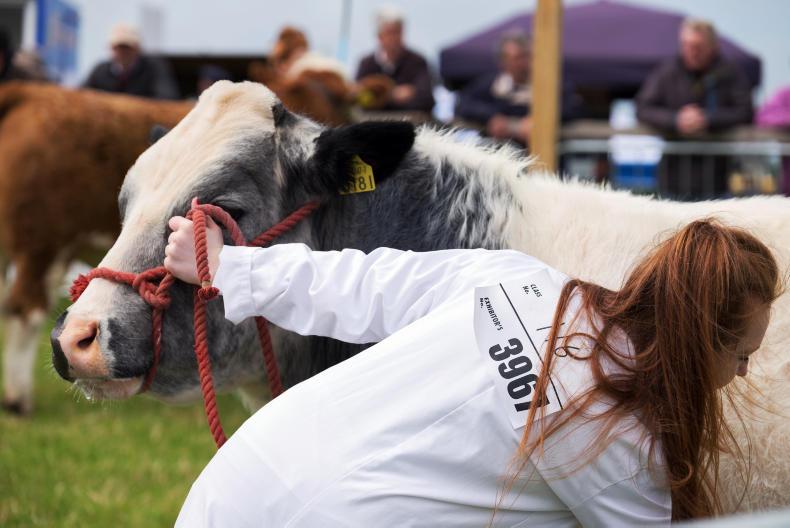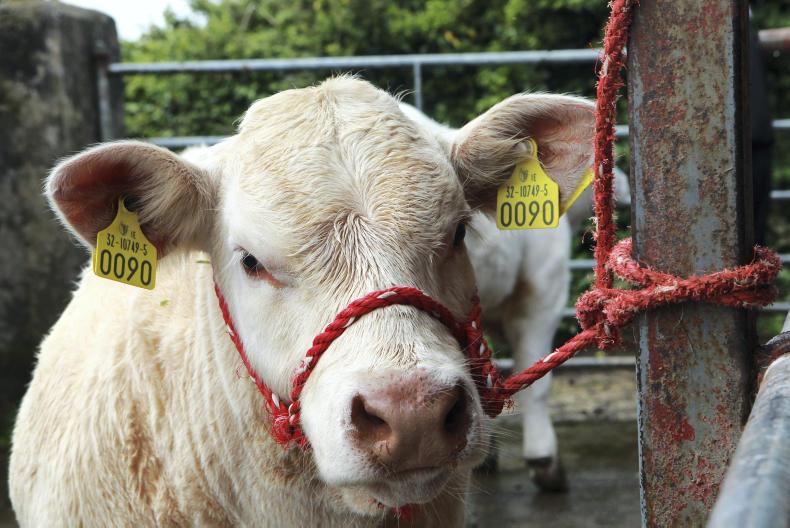While the long spring may not have been good for much, it offered pedigree breeders an opportunity to tie up and halter train some hopeful prospects for the summer show season.
Halter training animals takes time and the more time you put in, the quieter and better trained your animal becomes. The more the animal becomes accustomed to you, the quieter that animal will be for life, not just for a show.
While there are many philosophies of how to halter train animals, the best approach is to start young. The younger you start training an animal, the more it becomes accustomed to you. It is also the best way to reduce stress on both man and beast.
Whether the animal ever makes it to shows or sales, this time spent will not be wasted, as that animal will be quieter with regard to its handling for life.
Training calves is all about getting them familiar with you and showing them that you are in control. It is suggested that once animals are caught for the first time, that you simply tie them short to a sturdy pole or wall which they cannot hurt themselves on.
They should be tied so that they can rest their head in a natural position, with no more slack than 12in. By tying them short, it reduces the chance of the calf injuring itself.

For young calves, a soft rope should be used, but one that will still tighten and loosen underneath the jaw. It is this pressure which will teach the calf that pulling isn’t an option and that when it relaxes, the pressure will stop.
All animals tied up should never be left unaccompanied, as if they went down they would choke.
Once tied up, no walking should be done with the animal for a number of days. Instead get the animal used to you by scratching and combing them. You want the calf to remember that being tied up is a pleasant experience. Short tie-ups over a number of days will stand to them a lot better than one long training session on one day.
The way in which the animal is released is just as important as the method of tying up. You should untie the animal in a calm smooth manner and refrain from making any sudden movements. If possible, try to rub the animal once the halter is removed also, again reminding them that training is a pleasant experience.
At first, the calf will try to get away, but after three or four days of being tied, the calf will stop putting pressure on the rope. This demonstrates that the calf has learned that once the rope is on it cannot move.
Once the calf does this, it’s time to begin leading. Only do this in a small enclosed area where the calf cannot get away from you. This is the stage which will take time.
Every calf is different, but you need to teach the calf that if you put pressure on the rope, similar to when it was tied, that it must stop.
If a calf starts to pull to get away, it is essential to try to keep hold of the rope. Once a calf gets away, it will think it can do it again. This is also important when releasing the animal from the halter.
Once you get the calf to stop when you pull the rope, you can then begin trying to walk it beside you. Ideally, you want the calf to walk beside you without any pressure, but to do this you may first have to pull the rope to show it you want it to move.
You need to be patient and calm at this step; getting angry at the animal for not moving when you pull will only break the bond you have been building with it.
As your control of the calf progresses, you can start making the space in which you walk it bigger. Again, regular short training sessions stand to the calf a lot more than long irregular ones.
As mentioned previously, there are a number of other ways to train a calf. Some people leave the halter on the animal with just enough rope that its front legs can step on it. This method allows the animal to get used to the pressure of the halter, as they step on the halter repeatedly over a number of days.
It is advised to make regular checks on these animals to ensure they have not caught the halter on something or the halter has not come off. This method merely saves the first few days – the animal will still need to be trained to lead.
However, the biggest limitation with this method is the initial bond between the person and the animal is not gained.
Once an animal is broke to lead, you should practise as frequently as possible to both retain the bond and improve their response to the halter.
Remember that genetics play a huge part in an animal’s attitude and willingness to be trained, so each calf will be different.
Time spent on an animal is never time wasted. The better trained your calf, the better you can show it to its best advantage, which in turn will increase your chances of being placed and picking up a show rosette.
To those in the process of training or those with calves already trained, I wish you the best of luck in the show season ahead.
Summer shows
This year, similar to the last number of years, the Irish Farmers Journal is committed to bringing you all the up-to-date action from the 2018 summer shows season.
Representatives from our team will be out in force covering over 50 shows the length and breadth of the country throughout the summer. Show reports, along with pictures of the champions of all shows covered, can be found on farmersjournal.ie/pedigree.
While the long spring may not have been good for much, it offered pedigree breeders an opportunity to tie up and halter train some hopeful prospects for the summer show season.
Halter training animals takes time and the more time you put in, the quieter and better trained your animal becomes. The more the animal becomes accustomed to you, the quieter that animal will be for life, not just for a show.
While there are many philosophies of how to halter train animals, the best approach is to start young. The younger you start training an animal, the more it becomes accustomed to you. It is also the best way to reduce stress on both man and beast.
Whether the animal ever makes it to shows or sales, this time spent will not be wasted, as that animal will be quieter with regard to its handling for life.
Training calves is all about getting them familiar with you and showing them that you are in control. It is suggested that once animals are caught for the first time, that you simply tie them short to a sturdy pole or wall which they cannot hurt themselves on.
They should be tied so that they can rest their head in a natural position, with no more slack than 12in. By tying them short, it reduces the chance of the calf injuring itself.

For young calves, a soft rope should be used, but one that will still tighten and loosen underneath the jaw. It is this pressure which will teach the calf that pulling isn’t an option and that when it relaxes, the pressure will stop.
All animals tied up should never be left unaccompanied, as if they went down they would choke.
Once tied up, no walking should be done with the animal for a number of days. Instead get the animal used to you by scratching and combing them. You want the calf to remember that being tied up is a pleasant experience. Short tie-ups over a number of days will stand to them a lot better than one long training session on one day.
The way in which the animal is released is just as important as the method of tying up. You should untie the animal in a calm smooth manner and refrain from making any sudden movements. If possible, try to rub the animal once the halter is removed also, again reminding them that training is a pleasant experience.
At first, the calf will try to get away, but after three or four days of being tied, the calf will stop putting pressure on the rope. This demonstrates that the calf has learned that once the rope is on it cannot move.
Once the calf does this, it’s time to begin leading. Only do this in a small enclosed area where the calf cannot get away from you. This is the stage which will take time.
Every calf is different, but you need to teach the calf that if you put pressure on the rope, similar to when it was tied, that it must stop.
If a calf starts to pull to get away, it is essential to try to keep hold of the rope. Once a calf gets away, it will think it can do it again. This is also important when releasing the animal from the halter.
Once you get the calf to stop when you pull the rope, you can then begin trying to walk it beside you. Ideally, you want the calf to walk beside you without any pressure, but to do this you may first have to pull the rope to show it you want it to move.
You need to be patient and calm at this step; getting angry at the animal for not moving when you pull will only break the bond you have been building with it.
As your control of the calf progresses, you can start making the space in which you walk it bigger. Again, regular short training sessions stand to the calf a lot more than long irregular ones.
As mentioned previously, there are a number of other ways to train a calf. Some people leave the halter on the animal with just enough rope that its front legs can step on it. This method allows the animal to get used to the pressure of the halter, as they step on the halter repeatedly over a number of days.
It is advised to make regular checks on these animals to ensure they have not caught the halter on something or the halter has not come off. This method merely saves the first few days – the animal will still need to be trained to lead.
However, the biggest limitation with this method is the initial bond between the person and the animal is not gained.
Once an animal is broke to lead, you should practise as frequently as possible to both retain the bond and improve their response to the halter.
Remember that genetics play a huge part in an animal’s attitude and willingness to be trained, so each calf will be different.
Time spent on an animal is never time wasted. The better trained your calf, the better you can show it to its best advantage, which in turn will increase your chances of being placed and picking up a show rosette.
To those in the process of training or those with calves already trained, I wish you the best of luck in the show season ahead.
Summer shows
This year, similar to the last number of years, the Irish Farmers Journal is committed to bringing you all the up-to-date action from the 2018 summer shows season.
Representatives from our team will be out in force covering over 50 shows the length and breadth of the country throughout the summer. Show reports, along with pictures of the champions of all shows covered, can be found on farmersjournal.ie/pedigree.








 This is a subscriber-only article
This is a subscriber-only article











SHARING OPTIONS: